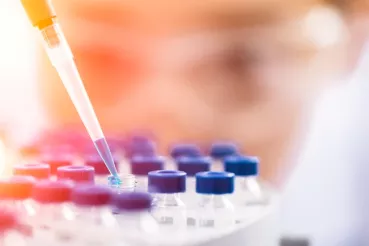Make room, cholesterol. A new disease marker is entering the medical lexicon: suPAR, or soluble urokinase-type plasminogen activator receptor. A study in the New England Journal of Medicine shows that suPAR, a circulating protein measured by a simple blood test, can reliably predict a person’s chances of developing chronic kidney disease as much as five years before this common killer starts causing damage.
The New England Journal of Medicine article appears in Online First, November 5, 2015 to coincide with the American Society of Nephrology’s Kidney Week meeting. It will also appear in the printed issue of the journal on Nov. 12.
“SuPAR promises to do for kidney disease what cholesterol has done for cardiovascular disease,” said Jochen Reiser, MD, PhD, senior author of the NEJM study and the Ralph C. Brown, M.D., Professor and chairman of Medicine, Rush University Medical Center. Four other medical institutions collaborated with Rush on the paper: Emory Clinical Cardiovascular Research Institute, Massachusetts General Hospital and Harvard Medical School, NYU Langone Medical Center and John H. Stroger, Jr., Hospital of Cook County.
Reiser believes that in the near future, high suPAR levels probably will inform physician-patient conversations about preventing kidney disease, just as high cholesterol levels signal the need for lifestyle changes and protective drugs, such as statins, to avert heart attacks and strokes.
The rigorous NEJM study is a significant breakthrough in preventive medicine. Earlier observations by Reiser and his laboratory suggested a role for suPAR in causing the kidney disease known as focal and segmental glomerulosclerosis (kidney scarring). While additional research is needed, the new results indicate a far more broader role for suPAR across all of chronic kidney disease and thus have major public health implications.
More than 15 percent of people in the U.S. have chronic kidney disease, and approximately 4 percent require dialysis and/or a kidney transplant due to kidney failure. In addition to reducing unnecessary deaths and improving quality of life, a significant decrease in kidney disease incidence would dramatically cut healthcare spending. In 2012, Medicare alone spent $87 billion on medical care provided to patients with chronic and end-stage kidney disease.
Looking for a better disease marker
In addition to cleaning the blood of excess waste and toxins, the kidneys help control blood pressure, make red blood cells and keep bones strong. When the kidneys stop functioning properly over months or years, it is known as chronic kidney disease. The most common causes are diabetes, high blood pressure and glomerulonephritis.
Chronic kidney disease causes about 47,000 deaths a year and is known as a silent killer, because most people don’t realize they have it until the disease is well advanced. Chronic kidney disease often causes severe organ damage before symptoms — such as blood in the urine, swollen hands and feet, and excessive thirst — develop.
In the advanced phases, patients develop serious complications, including high blood pressure, and eventually the kidneys may fail. However, because the heart works very intimately with the kidneys, most people with kidney disease die of heart problems before their kidneys give out.
Currently, physicians rely on two markers to detect and manage chronic kidney disease:
- Estimated glomerular filtration rate (eGFR), based on measuring creatinine in the blood, indicates how well the kidneys filter waste
- Proteinuria, or high protein levels in urine
While these disease indicators are very helpful in monitoring existing kidney disease, they are not sensitive enough to catch the disease in its early stages or to predict a person’s risk of developing the disease.
That shortcoming is what makes the NEJM study so important. It found that a high suPAR level was an excellent predictor of future kidney disease. The researchers measured suPAR levels and kidney function (based on eGFR rates) in 2,292 people at baseline and again at follow up. Of these subjects, 40 percent of subjects with high suPAR levels (greater than 3,040 ng/mL) but no known kidney disease (i.e. healthy eGFR levels) went on to develop chronic kidney disease over the course of five years. In comparison, only 10 percent of those with low suPAR levels at baseline developed the disease. Moreover, suPAR was shown to predict eGFR decline in patients with already established earlier stage kidney disease as well.
“We can now stratify people according to their risk of develop kidney disease using suPAR levels,” explains Dr. Salim Hayek, first author of the study and fellow at the Emory Clinical Cardiovascular Research Institute. Using the Emory Cardiovascular Biobank, a cohort of patients with cardiovascular disease (excluding patients with cancer or active inflammation), the study divides suPAR levels into four quartiles:
- Normal suPAR: less than 2,373 picograms per milliliter (pg/mL)
- Above normal: 2,373-3030 pg/mL
- High: 3,040-4,020 pg/mL
- Very high: above 4,020 pg/mL
Determining the actual risk
How much does a person’s risk of chronic kidney disease go up as suPAR levels rise? The exact answer will depend on other risk factors and requires more research, explains Reiser. It is also not the same risk in every cohort, as the study measured suPAR in two unique patient cohorts.The primary findings described above are based on patients in the Emory Cardiovascular Biobank, a massive collection of blood samples taken from patients who underwent cardiac catheterization between 2003 and 2009.
In this cohort, subjects with very high suPAR levels (i.e., greater than 4,020) correlated with a very high chance — 80 percent — of developing kidney disease in 10 years, according to Reiser. Researchers statistically controlled for certain factors known to increase suPAR levels, including cancer and inflammation. But when the researchers looked at a second patient cohort – women in the Women’s Interagency HIV Study (WIHS) — they found a significant yet smaller risk than in the Emory cohort. “The most likely reason is because people in the Emory cohort were older and at greater risk for kidney disease than the younger, heart-healthier women in the WIHS cohort,” said Audrey French, MD, co-author of the study, and a Professor of Medicine at Stroger Hospital of Cook County. After controlling for HIV, which is known to elevate suPAR, the researchers confirmed their initial findings that high suPAR levels predict future decline of kidney function.
“Not every cohort has the same risk as another cohort,” explains Dr. Arshed Quyyumi, co-correspondent author of the study and director of the Emory Clinical Cardiovascular Research Institute. “That’s why it’s going to be important to look at suPAR levels in a few more cohorts before we can accurately predict risk for different patients.”
Trumping other risk factors
Yet, the main takeaway from the NEJM study holds true: “High suPAR is bad news for the kidneys,” according to Quyyumi. Another important finding from the study is that suPAR seems to be a more powerful predictor of chronic kidney disease than other previously known high risk factors. For instance, blacks are known to have a higher risk of the disease than whites, which is explained in part by the discovery that people of African dissent are more likely to carry the APOL1 risk gene, which increases likeliness of developing some kidney diseases. “What we’ve shown is that it doesn’t matter whether our subjects were black or white. SuPAR was a strong independent predictor of eGFR decline. APOL1 gene polymorphism is a genetic risk factor for renal disease in the black population, but suPAR’s power to predict renal disease appeared not be majorly different in black or white patients,” said Dr. Sanja Sever from Massachusetts General Hospital and Harvard Medical School and the study’s co-first author.
Reiser is also excited by the study’s finding related to diabetes. While diabetes is the number one cause of chronic kidney disease, only about one-third of patients with diabetes develop diabetic kidney disease. “Today, nobody knows which patients with diabetes will get the disease,” explains Reiser. “In our paper we show that among patients with diabetes, the ones with elevated suPAR at baseline were more likely to develop kidney disease. This will help risk-stratify specifically patients with diabetes on their risk of future kidney disease.” This possibility has huge implications for clinical trials and drug testing, he said. Today, about two thirds of the patients enrolled in studies of new drugs for diabetic kidney disease probably will never develop kidney disease. Now, researchers can identify which of the subjects have high suPAR levels before enrolling them. “This ability will make the trials a lot shorter, a lot cheaper, and probably more successful,” said Reiser.
Anticipating suPAR blood tests
In the near future, Reiser anticipates that many healthcare providers will start measuring patients’ suPAR levels on a regular basis to detect kidney risk, just as they measure cholesterol and blood pressure levels to predict heart disease. Today, suPAR blood tests are primarily only used for research in the United States. The tests are not yet approved by the Food & Drug Administration, which makes it difficult for providers to use them in direct patient care. Yet, Reiser believes momentum will build for FDA approval of the tests, which are inexpensive. In addition to being an indicator of future kidney disease, high suPAR levels have been found to be associated with severe sepsis, cardiovascular disease, and some other serious health problems. Some hospitals in Europe, where the tests are easily available, are measuring suPAR in emergency department patients to quickly triage those needing rapid medical care.
Developing novel treatments
Once physicians know which patients have high suPAR levels, they can counsel them on ways to lower their risk of chronic kidney disease. Many of the same lifestyle issues that lead to heart disease also cause suPAR levels to rise: smoking, an unhealthy diet, and being overweight/obese. “One characteristic of suPAR is that it is modifiable to some degree by lifestyle,” said Reiser. “Also, if suPAR is high, we can be more aggressive in terms of giving medications to control high blood pressure and diabetes, which contribute to chronic kidney disease.”
In addition, early work is under way by a biopharmaceutical company to develop novel drug therapies that would neutralize suPAR. However, many scientific and regulatory hurdles need to be crossed before these drugs are available.“We may envision an injectable antibody that binds to suPAR and basically neutralizes it,” said Reiser. SuPAR, which is a waste product of the immune system, is not believed to be needed to maintain good health. This theory is supported by animal studies. Reiser and fellow researchers at Rush have been studying mice bred without suPAR — and the mice show no overt signs of disease.
“The observation that high suPAR levels predict the future development of chronic kidney disease in different populations suggests this molecule may be a target for treatment to improve clinical outcomes in the majority of patients at risk for future kidney disease. Blocking suPAR may prove to be comparable in its application to the use of angiotensin converting enzyme inhibitors and angiotensin receptor blockers which are among the few drugs approved for treatment of chronic kidney disease,” said Howard Trachtman MD, a pediatric nephrologist at NYU Langone Medical Center and co-author on the paper.
Continuing to study suPAR
Researchers are continuing to study suPAR to identify forms of the protein that are associated with different types of chronic kidney disease. Some types of kidney disease are relatively mild and take years to worsen, while others advance quickly and/or more severely. While it is not yet known how, scientists theorize that different forms of suPAR play a pathological role in causing different forms of kidney disease. For instance, Reiser has been studying one particularly aggressive form of kidney disease— focal segmental glomerulosclerosis (FSGS) — for decades. FSGS, also known as kidney scarring disease, attacks newly transplanted kidneys sometimes within hours of the operation. Previous research by Reiser and his colleagues linked level of suPAR and a specific and toxic form of the molecule to FSGS.
“So the form of suPAR matters as well as the level of suPAR in the blood,” explains Reiser. This relationship will need to be better understood in the future. “The New England Journal of Medicine paper focuses only on suPAR levels. It doesn’t differentiate between different forms. It’s sort of like cholesterol. In that paper, we are measuring total cholesterol. But eventually, we hope to be able to differentiate between different types of suPAR just like we can measure LDL, HDL, and other forms of cholesterol.”
##
The study was funded in part by grants from the National Institutes of Health and other funding agencies. Reiser and Sever are co-founders of TRISAQ, a biopharmaceutical company working on novel drug therapies for kidney disease.



